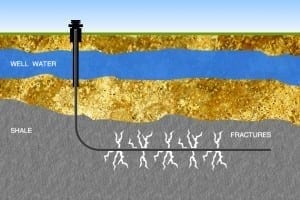6/7/2015
One of the major environmental concerns since the beginning of this decade has been the use of hydraulic fracturing, or “fracking” to unearth natural gas and oil shale reserves. The process uses high-pressure water among other substances to create or to widen holes into the shale formation in order to release the gas or oil. Although the process, in addition to the discovery of the Bakken reserves in North Dakota, has created an energy boom in the U.S., increasing evidence shows that this may be coming at a large environmental price. Homeowners and environmental groups alike have accused the process of contaminating wells and drinking water supplies. Many have also cited that earthquakes over 2.5 on the Richter scale have increased dramatically, especially in states like Ohio and Texas since fracking began. That is why a 998-page report issued by the U.S. Environmental Protection Agency (EPA) on June 4th will likely be used as ammunition for any conceivable position on fracking. Although the report does cite some degree of contamination, it comes to the conclusion that there is no evidence that fracking causes widespread drinking water pollution. The report did cite, however, that evidence is mounting that the process has led to an increase in seismic activity. The Wall Street Journal reports that Texas state regulators have called for a hearing next week with Exxon, as well as several of its subsidiaries over the process’s seismic effects.

In a mixed-message, the report states that fracking has the potential to impact drinking water sources; but that the EPA “did not find evidence that these mechanisms have led to widespread, systemic impacts on drinking water resources.”The conclusions in the report will likely mean that there will be no changes to federal water regulations beyond measures that have already been implemented. Activists note, however, that the conclusions do not find claims of pollution to be meritless, but inconclusive instead. The methodology of the study, which began in 2010, has been regarded as highly questionable. Nearly every company involved in the process, including Chesapeake Energy, Halliburton, and Exxon, among others refused to allow the EPA to conduct baseline studies necessary to measure the effects over time. The energy companies were not legally compelled to cooperate with the agency, largely due to the 2005 “Halliburton Loophole” included in the Safe Drinking Water Act, at the strong urging of former Halliburton CEO and U.S. vice-president, Dick Cheney. The loophole is only one example of what one former senior EPA official called “a microcosm of the relationship between industry and EPA.” Says lobbyist, Michael McKenna, “That is as close as the federal government gets to saying, ‘I’m not that interested in you.’” The Obama administration has supported a robust energy policy including fracking, although he did introduce stricter regulations in March for fracking on public land, including disclosure of chemicals used and companies’ construction standards for well-building. Most fracking occurs on private land, however, which is not included in the new regulations.
In Texas, state-level regulators have begun to take a tougher stance on the process that may, in-time, alter the future of fracking. The problem of earthquakes, although relatively minor but potentially dangerous, has increased at a dramatic pace, especially in the shale-rich North Texas area that is home to over 6.5 million people. So far in 2015, 23 earthquakes of 2.5 magnitude or higher have struck North Texas. A growing body of research, including the recent EPA report, has noted a strong link between fracking and seismic activity. A recent study conducted by Southern Methodist University noted a connection between a wastewater well from XTO Energy and a drilling well from Exxon to a series of earthquakes near Fort Worth. The Railroad Commission of Texas, the state’s energy-sector regulator, has begun a pushback against the industry, which of course, maintains a strong presence in the state. In addition to requiring that no new disposal wells can be constructed without evaluating historical U.S. Geological Survey data for a 100 square-mile area surrounding the proposed site, the agency will meet with Exxon, XTO Energy, among others in hearings from June 10th through June 16th. This comes after the commission changed its permitting rules late last year to allow the commission the right to shut wells down if scientific evidence points to the well causing seismic activity. Although some on the commission as well as most of the energy producers have argued that their operations do not cause earthquakes, even ConocoPhillips CEO, Ryan Lance, conceded last month that there is some link, saying “We’ve followed all the data and the evidence and it does appear that in some areas water disposal is creating seismic events. We’re trying to understand how widespread it is.”
The mixed-results of the EPA study regarding drinking water, fueled in part by the deep pockets of the energy lobby, does differ from the more concrete evidence linking fracking to earthquakes. The bigger questions remain, will seismic activity grow worse with additional fracking, and should fracking be banned completely? In places like Dallas, Mayor Mike Rawlings is contemplating a change in building codes to increase the standards in the formerly earthquake-rare city. Homeowners in Pennsylvania would disagree with the EPA’s findings, as many of them near fracking operations have brine-water in their wells. Fracking and the energy boom in general has been a major cause of the United State’s rise from the Great Recession, creating boomtowns in places like North Dakota, as well as helping to drive down the cost of gasoline and home heating. Texas, and specifically, the future actions of the Texas Railroad Commission, may serve as a bellwether for the rest of the country regarding fracking. The results may also help to negotiate the battle between scientific evidence and industry pressure.
Sources:
Bloomberg Business – Mark Drajem and Jim Snyder
EcoWatch – Wenonah Hauter
Inside Climate News – Neela Banerjee
Wall Street Journal – Erin Ailworth


Join the conversation!